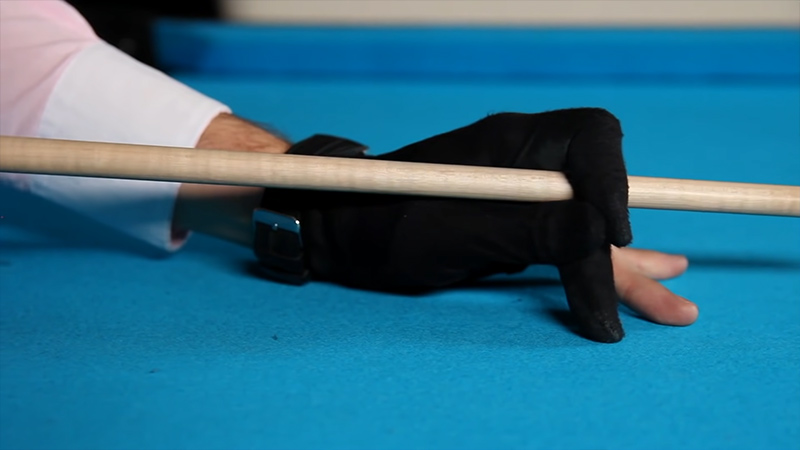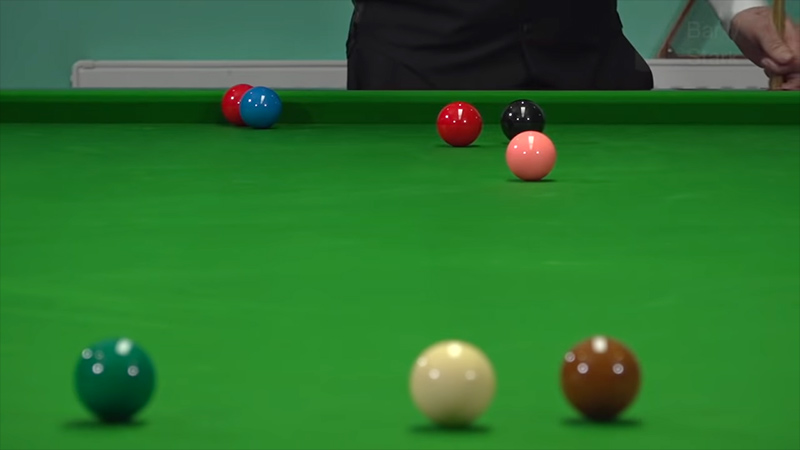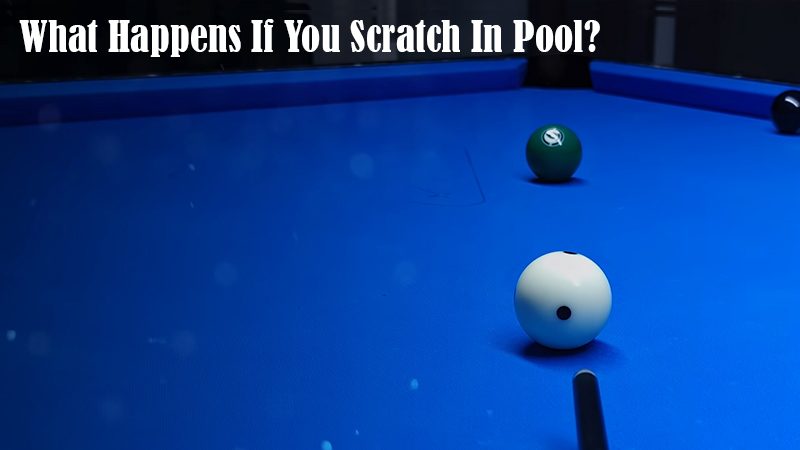Billiards, commonly known as pool, is a game of precision, strategy, and finesse.
Success on the felt often hinges not just on making shots, but on avoiding costly errors that can shift momentum and grant significant advantages to your opponent. Among the most frequent and impactful fouls is the “scratch”.
A scratch in pool fundamentally refers to a game foul involving the cue ball. While the term is often associated with pocketing the cue ball or hitting an illegal object ball first, the definition is broader, encompassing several specific scenarios on the table.
Understanding what constitutes a scratch is paramount because they carry penalties that can dramatically alter the course of a game.
Avoiding scratches is not merely about following the rules; it is essential to winning, especially when playing against skilled opponents who can capitalize on the opportunity you provide.
It’s important to note that while the core concept of a scratch is universal, the specific rules and consequences can vary slightly depending on the game format being played, as well as between different leagues and regulatory organizations.
However, the official and commonplace rules for popular games like 8 ball and 9 ball are largely identical when it comes to scratches.
This guide will focus primarily on these prevalent formats while also touching upon unique scratch rules in less common games like One Pocket and Straight Pool.
By clarifying these rules and addressing common misconceptions, you can elevate your game and minimize the detrimental impact of scratches.
The Different Types of Scratches in Pool
Identifying Fouls: The Various Ways You Can Scratch
Scratches can occur in several distinct ways during a pool game. While some are well-known, others are more obscure and can catch inexperienced players off guard.
Understanding each type is the first step to avoiding them. The sources describe several different kinds of scratches.
When the Cue Ball Goes In
The most common type of scratch, and perhaps the most straightforward, occurs when the cue ball falls into a pocket.
This is often referred to as a “pocket scratch”. If you strike the cue ball and it enters any pocket on the table, it is always a scratch.
It doesn’t matter what the cue ball hits first, or even if it hits anything at all before dropping.
This is a fundamental rule across most pool variants. Pocket scratches contrast with “table scratches,” where the cue ball remains on the playing surface but a foul occurs.
Hitting the Wrong Ball First
Another very common type of scratch involves striking an illegal object ball first with the cue ball.
An object ball is any ball on the table other than the cue ball. This foul is contingent on the first ball the cue ball makes contact with.
This is typically classified as a table scratch because the cue ball usually remains on the table.
The definition of an “illegal object ball” depends on the game being played:
- In 8 ball: If you are shooting at stripes, your cue ball must make contact with a stripe first. If you hit a solid ball or the 8 ball first while you still have stripes on the table, it is a scratch. Similarly, if you are solids, you must hit a solid first. Hitting a stripe or the 8 ball first while you still have solids remaining is a scratch.
- In 9 ball: The rules dictate that the cue ball must always first contact the lowest numbered ball remaining on the table. Any ball that is not the lowest number currently on the table is considered an illegal object ball. For example, if the 3 ball is the lowest numbered ball, and you hit the 5 ball first, it is a scratch.
This rule necessitates awareness of which balls are legally playable at any given moment in the game.
Failing to Make Contact
A basic, though less frequent, scratch occurs when the cue ball fails to strike any object ball during a shot.
Regardless of how the shot is executed or what else happens on the table, if the cue ball does not make contact with an object ball, it is a scratch.
The cue ball can hit rails multiple times, but if it doesn’t touch an object ball at some point, it’s a foul.
The Cue Ball Leaves the Table
If, during a shot, the cue ball leaves the playing surface entirely, it is considered a scratch.
This can happen for various reasons, such as hitting the ball with excessive force causing it to jump off a rail, or attempting a jump shot that results in the ball flying off the table. However, it is explicitly stated that it is not a scratch if the cue ball jumps up, lands on a rail, but then rolls back onto the playing surface.
If object balls leave the table during a shot, they stay off the table and do not count as pocketed. If you are playing 9 ball and the 1 ball leaves the table, it does not count as pocketed, and your turn ends.
Accidental Touches or Movements
Any form of touching, moving, or manipulating the cue ball by the player or their equipment, other than a legal strike with the cue tip, constitutes a scratch.
This includes accidentally brushing against the ball with your hand, tapping it with your stick, or gently pushing it.
The cue ball can only be moved legally by being struck by the cue or by being placed on the table when a player has “ball in hand” after a scratch.
A point of clarification often arises regarding accidental touches of object balls. In most leagues, accidentally touching an object ball is not a scratch.
However, in professional play, this can result in a ball-in-hand foul for the opponent.
There are also variations in casual games and some amateur play where accidentally moving the cue ball might not be considered a scratch; instead, the cue ball is simply moved back to its original position, and play continues.
This highlights the difference between formal rulesets and common informal “bar rules.”
Hitting the Cue Ball Twice
A “double-hit” is a scratch that occurs when the player strikes the cue ball twice on the same shot.
This foul typically happens when the cue ball and the object ball being aimed at are located very close to each other, often within a few inches.
Detecting a double-hit can be challenging and requires close attention to the sound and movement of the balls.
The sources provide a good indicator: if the cue ball and a very close object ball travel away from the cue at roughly the same speed, it is almost certainly a double-hit.
A cue ball normally loses momentum upon striking an object ball, so if both move together at the same speed, it signals that the cue tip has propelled both balls forward simultaneously.
The sound can also be a clue; instead of a single “thump” from the cue striking the cue ball followed by a “clink” from the cue ball hitting the object ball, a double-hit might produce two distinct “thumping” sounds and multiple clinks.
No Ball Hits a Rail or Goes In
This is described as one of the more obscure scratches and a potential source of debate in casual settings.
It is a foul if the cue ball legally strikes a legal object ball, but after this initial contact, neither the cue ball nor any object ball subsequently hits a rail or goes into a pocket.
To break this down: after the cue ball makes legal first contact with an object ball, for the shot to be considered legal, something must happen involving a rail or a pocket. The possibilities are:
- The cue ball hits a rail.
- The object ball that was struck hits a rail.
- The object ball that was struck goes into a pocket.
- Either the cue ball or the object ball that was struck hits another object ball, and that second object ball then hits a rail or goes into a pocket.
If none of these outcomes occur after the initial legal contact, the shot is a scratch.
For instance, in 8 ball, if a player legally hits a stripe, but the cue ball stops in the middle of the table, and the stripe also stops without hitting a rail or going in, it’s a scratch.
The Consequences of Scratching
What Happens When You Scratch?

The penalty for scratching is designed to be significant, as it typically gives the opposing player a substantial advantage.
The consequences vary slightly depending on the game format and the specific type of scratch, particularly in different league rules.
The Standard Penalty: Ball in Hand
In standard 8 ball and 9 ball games, the most common consequence of a scratch is that the opposing player receives “ball in hand”.
This is a powerful advantage. With ball in hand, the opponent has the right to pick up the cue ball and place it anywhere they want on the table before taking their shot.
This ability to place the cue ball anywhere is a “big deal”. It allows the opponent to set up an easy shot on a difficult ball, position themselves for a potential “run out” (pocketing all remaining balls in their set without missing), or execute a strategic defensive shot from an advantageous position.
Giving an opponent ball in hand significantly increases their chances of winning the game or gaining a commanding lead.
Losing the Game on the 8 Ball
In 8 ball, there is a specific, severe consequence if a scratch occurs in conjunction with attempting to pocket the 8 ball. If a player has successfully pocketed all of their object balls (solids or stripes) and is now shooting at the 8 ball, and they pocket the 8 ball but simultaneously pocket the cue ball or the cue ball leaves the table, they lose the game.
This rule is widely followed in many amateur leagues like APA, TAP, and BCA. It underscores the critical importance of precision when attempting the final shot.
The 9 Ball Exception
9 ball has a unique rule regarding pocketing the 9 ball and scratching. In 9 ball, the goal is to legally pocket the 9 ball.
If a player legally pockets the 9 ball (either directly or by hitting the lowest numbered ball first which then causes the 9 ball to go in), but the cue ball goes into a pocket or leaves the table on the same shot, the 9 ball is not considered legally pocketed. Instead, the 9 ball is “spotted”.
Spotting means the 9 ball is removed from the pocket and placed back onto the table at the headspot (the designated spot at the top of the table). The opposing player then receives ball in hand.
If the 9 ball was the only ball remaining on the table when this scratch occurred, the opponent receiving ball in hand will likely be able to pocket the spotted 9 ball easily, almost always resulting in a loss of game for the player who scratched.
Pocketed Balls Remain Down
A general rule across most common pool games is that any object ball pocketed during a scratch shot remains in the pocket.
The only exception mentioned in the sources is the 9 ball in the scenario described above. Neither object balls nor the 8 ball (unless it’s the game-losing scenario) are put back on the table after being pocketed on a scratch.
How to Avoid Common Scratches?
Techniques to Keep the Cue Ball Out of Trouble
Minimizing scratches is a crucial skill for improving your pool game. Fortunately, there are specific techniques and principles rooted in physics and geometry that players can learn and apply to better control the cue ball’s movement and avoid fouling. Consistently working on these aspects of your technique is key.
Understanding Cue Ball Path
A fundamental concept for predicting where the cue ball will go after striking an object ball is the tangent line.
The tangent line is an imaginary line that is perpendicular to the line between the centers of the cue ball and the object ball at the exact point of contact.
If you hit the cue ball in its center without imparting any spin (English), the cue ball will always travel along this tangent line after hitting the object ball.
Visualizing the tangent line before each shot can help you anticipate the cue ball’s direction and identify potential scratches, particularly into pockets.
For example, if the tangent line points directly into a pocket, you know a straight, center-ball hit will result in a scratch. Practicing with aids or simply imagining this line can significantly improve your prediction skills.
Using Spin
Once you understand the tangent line, the next level of cue ball control involves using spin. Applying spin allows you to alter the cue ball’s path away from the tangent line.
- Draw: Hitting the cue ball below its center imparts draw (backspin). After striking the object ball, the backspinning cue ball will tend to pull back towards the shooter or stop more quickly than a center-ball hit, effectively shortening its travel along the tangent line or even reversing its direction. This is useful for avoiding a scratch when the tangent line leads into a pocket just beyond the object ball.
- Follow: Hitting the cue ball above its center imparts follow (topspin). After striking the object ball, the topspin causes the cue ball to roll forward more after contact. This can be used to extend the cue ball’s travel along or forward of the tangent line. If the tangent line points just beside a pocket, follow can sometimes be used to angle the cue ball slightly further past the pocket opening.
Learning to consistently apply the correct amount of draw or follow allows you to “steer” the cue ball away from danger zones like pockets.
Handling Balls Near Pockets
A frequent scenario leading to scratches is when the object ball is located very close to a pocket.
If you hit the object ball straight on in this situation, the cue ball will often follow the object ball directly into the pocket. To avoid this, a technique called “cheating the pocket” is recommended.
Cheating the pocket involves hitting the object ball not straight into the center of the pocket, but slightly to the side, typically at about a 30-degree angle relative to the pocket’s centerline.
The object ball is still aimed to enter the pocket, but at an angle, hitting the side of the pocket opening. Because pool pockets are wider than the balls themselves, this is possible.
By hitting the object ball at this angle, the cue ball follows the tangent line which is now directed towards a rail next to the pocket, rather than directly into the pocket itself.
This allows the object ball to go in while the cue ball safely hits the cushion and stays out of the pocket.
Controlling Your Power
Many new or less experienced players tend to hit the cue ball much harder than necessary. While sometimes required, excessive power on a shot is not inherently bad, but it significantly increases the distance the cue ball will travel after hitting the object ball.
The farther the cue ball travels, the higher the probability it will encounter a pocket or go off the table, thus increasing the odds of a scratch.
Learning to hit at a reasonable speed and controlling your power is vital for cue ball management.
You might be surprised by how little force is actually needed to pocket a ball or get the cue ball into desired position. The sources suggest practicing shots with minimal power to understand the threshold of force required.
If you frequently find yourself scratching into pockets, especially distant ones, it’s a strong indication that you are hitting the ball too hard. Slowing down your shot speed can be a simple yet effective way to reduce scratches.
Debunking Common Scratch Misconceptions
“Bar Rules” vs. Official Rules: What’s Not a Scratch?
Pool is a game with a rich history and many regional or informal variations in rules. This has led to several widespread misconceptions about what constitutes a scratch or the resulting penalties.
These “bar rules” often differ significantly from the official rules used in competitive leagues and professional play. Clarifying these myths is important for anyone looking to play by standard rules.
Cue Ball Placement After a Scratch
A very common misconception is that after any scratch, the opposing player must place the cue ball behind a specific line, typically the “head string” (the line at the breaking end of the table).
This is not generally true in most games like 8 ball and 9 ball when the opponent gets ball in hand. With ball in hand, the opponent can place the cue ball anywhere on the entire playing surface.
The source clarifies that there are specific exceptions where the cue ball must be placed behind the head string:
- A scratch that occurs on the break in the APA (American Poolplayers Association) 8 ball league or UPA (United States Professional Poolplayers Association) professional play requires the opponent to shoot from behind the head string.
- All scratches in One Pocket pool require the cue ball to be played from behind the head string.
Outside of these specific scenarios and games, ball in hand means placing the cue ball anywhere.
The Myth of the 3-Bank Rule
Another entirely fictional rule sometimes encountered in casual settings is the “3-bank,” “3-rail,” or “3-wall” rule.
This myth suggests that if a player shoots the cue ball, it hits three different rails, but doesn’t hit any ball, it is somehow not a scratch.
The sources explicitly state that there are no pool formats where this is true. As discussed earlier, it is always a scratch if the cue ball fails to strike a legal object ball.
You must always hit a legal object ball, and then subsequently, a ball or the cue ball must hit a rail or go into a pocket.
Specific Pockets for the 8 Ball
In 8-ball, there are common informal rules regarding how the 8 ball must be pocketed.
Popular variations include requiring the 8 ball to be sunk in the same pocket where the player sank their last object ball, or requiring the 8 ball to be banked into any pocket.
The sources state that any billiards association or tournament director uses none of these requirements.
These are not official rules unless agreed upon informally between the players beforehand. You can legally pocket the 8 ball in any pocket you call, as long as you make the shot legally.
Failing to Call Your Shot
In 8 ball, it is standard practice in many rulesets to “call your shot” when it’s not obvious which ball you are aiming at and into which pocket.
While failing to call a non-obvious shot is a foul, the sources clarify that it is never a scratch.
Some players mistakenly believe this results in a scratch and ball in hand for the opponent, but this is incorrect.
It is a foul, but the penalty is less severe than a scratch; the opponent does not get the ball in hand.
In 9-ball, which is often played as a “slop” game, calling shots is generally not required at all, especially in non-professional play.
Illegally Jumping the Cue Ball
Attempting to make the cue ball jump over an intervening ball is a legitimate shot in pool under specific conditions.
However, there is an illegal method of attempting a jump shot. It is a scratch to “scoop” the cue ball, which involves hitting the bottom of the cue ball with the cue tip and sliding the stick underneath the ball to lift it. The only legal way to jump the cue ball is by striking the top of the ball with a downward angle.
Scooping the cue ball is always considered an illegal shot and results in a ball-in-hand scratch for the opponent.
Scratch Rules in Other Pool Games

Unique Scratch Rules in One Pocket and Straight Pool
While 8 ball and 9 ball are the most common pool games, others like One Pocket and Straight Pool have different objectives and, consequently, unique rules regarding scratches. Understanding these variations is important if you play these formats.
One Pocket Pool Scratches
In One Pocket, the objective is to be the first player to pocket 8 balls into a specific pocket assigned to them. Standard scratch rules apply regarding first contact with a legal ball and the cue ball going into a pocket. However, the penalty for a scratch is different from 8 ball or 9 ball:
- There is no ball in hand in One Pocket. For table scratches (where the cue ball stays on the table), the cue ball is played from wherever it comes to rest. For pocket scratches (where the cue ball goes in), the cue ball must be played from anywhere behind the head string.
- When a player scratches, they “owe a ball” and lose 1 point from their score.
- If a player owes a ball, the next ball they legally pocket does not count towards their 8-ball goal. Instead, that ball is spotted (placed back on the table near the headspot) at the end of the player’s turn. They do not receive points for it, but they do continue shooting if they made a legal hit and pocketed the ball (which was then spotted).
Straight Pool (14.1) Scratches
Straight Pool, also known as 14.1 Continuous, is a point-based game where players score points by pocketing balls. The goal is typically to reach a predetermined score, often 50 or 100 points. When only one object ball remains on the table, the other 14 balls are re-racked, leaving a gap at the headspot, and play continues.
Standard scratch rules regarding pocketing the cue ball or failure to hit a legal ball apply.
Similar to One Pocket, there is no ball in hand in Straight Pool. Table scratches are played where the cue ball stops, and pocket scratches are played from behind the head string.
The unique penalty in Straight Pool involves point deductions for scratches:
- The first scratch costs the player 1 point.
- A second consecutive scratch costs an additional 2 points, totaling 3 points lost over two turns.
- A third consecutive scratch incurs an additional 15-point penalty. After three consecutive scratches, the opponent has the choice to either play the balls from their current position or demand a re-rack of all 15 balls, forcing the fouling player to break again. This severe penalty for consecutive fouls emphasizes careful play.
Key Takeaways for Better Pool Play
Minimizing Scratches to Maximize Wins
Understanding the nuances of scratches and their consequences is not just about knowing the rules; it’s a fundamental aspect of strategic pool play.
Avoiding scratches is paramount and essential to winning because they almost invariably provide the opposing player with a significant advantage, most commonly “ball in hand”.
Giving your opponent the ability to place the cue ball anywhere they choose offers them an easy opportunity to control the table, make a difficult shot, or even run out the game. If you miss a legal shot without scratching, the opponent might be left with a challenging layout, whereas a scratch guarantees them a favorable position.
Remember that the most common types of scratches are pocketing the cue ball and hitting an illegal object ball first. Be particularly vigilant to avoid these scenarios.
Pocketing the cue ball can often happen unexpectedly, especially when hitting object balls near pockets or using excessive force.
Hitting the wrong ball first is a risk when required to “kick” at a ball (hitting a rail before the object ball to get around an obstruction) or when the table is crowded.
To effectively minimize scratches, you must continuously work on your technique. Develop your ability to predict the cue ball’s path using the concept of the tangent line.
Practice applying draw or follow to control the cue ball’s movement after impact, steering it away from pockets or into safer areas of the table. Critically, learn to control the speed of your shot.
Hitting the ball slower often provides more control and reduces the distance the cue ball travels, lessening the chance it will find a pocket unintentionally.
If you notice you are scratching frequently, it’s a strong signal that you are likely hitting too hard. Slow down, focus on precision, and use just enough power to get the job done.
By mastering cue ball control and diligently applying these techniques, you can significantly reduce the frequency of scratches, keep the advantage on your side of the table, and dramatically improve your win rate.







